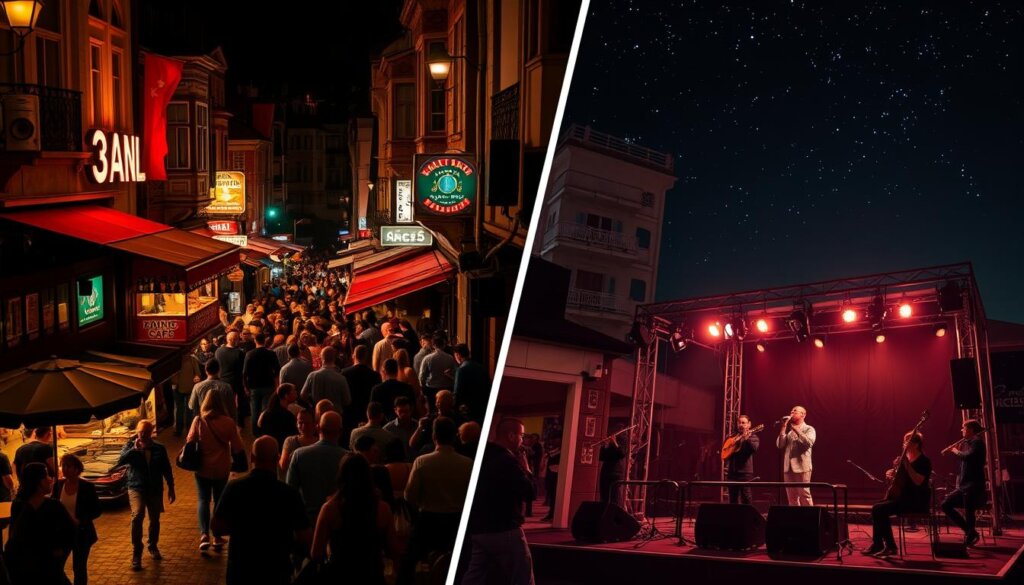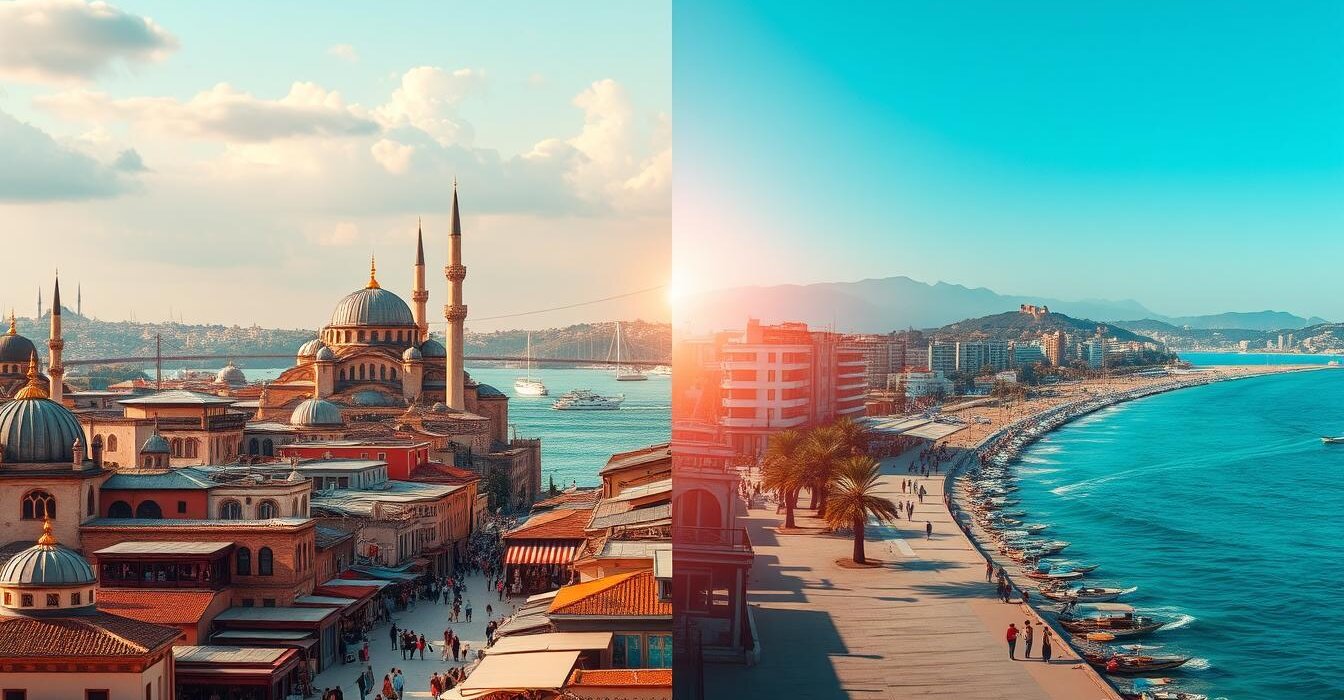Did you know that over 16 million travellers visited Turkey’s Mediterranean and Marmara regions last year, with many torn between exploring bustling metropolises and unwinding at coastal resorts? As someone who’s helped thousands of visitors since 2006, I’ve seen firsthand how choosing between these two destinations can shape your entire holiday experience.
Table Of Content
- Key Takeaways
- Introduction to Istanbul and Antalya
- Overview of Each City’s Unique Character
- Traveller Trends and Popularity
- Detailed Comparison of Public Transit and Walkability
- Public Transport Systems: Urban Pulse Versus Coastal Ease
- Navigating Streets and Squares
- Cultural and Historical Attractions in Istanbul and Antalya
- Imperial Splendour Meets Living History
- Coastal Relics and Quiet Discoveries
- Experiences Through Time
- Comparing Food and Culinary Experiences
- Iconic Dishes and Unique Local Flavours
- Culinary Traditions and Restaurant Scenes
- Shopping Experiences and Retail Delights
- Traditional Bazaars Versus Modern Malls
- Nightlife, Music, and Entertainment Scenes
- Nightlife Hotspots and Party Districts
- Live Music and Cultural Performances
- Outdoor Activities, Beaches and Natural Attractions
- Coastal Bliss and Turquoise Waters
- Trails and Urban Oases
- Accommodation Options from Luxury Resorts to Boutique Hotels
- Luxury and All-Inclusive Resorts
- Family-Friendly and Budget Accommodation
- Seasonal Considerations: When to Visit
- Summer Versus Winter Experiences
- Weather Patterns and Tourist Seasons
- Cost of Travel and Investment Opportunities
- Budget Comparisons
- Seasonal Pricing Variations
- Investment Insights
- Istanbul vs Antalya: Which City is Better to Visit?
- Matching Locations to Holiday Goals
- Conclusion
- FAQ
- Which city offers better value for money during peak tourist seasons?
- Can I visit both cities in a 7-day trip using public transport?
- Which destination has more UNESCO World Heritage Sites?
- Where can I find better street food options?
- Which city has more family-friendly beaches?
- Where can property investors get better rental yields?
- Which city has more vibrant live music venues?
- Are there significant weather differences in spring months?
- Which city offers better day trip opportunities?
- Where can I experience authentic Turkish hamams?
This guide compares Turkey’s cultural heartland with its sun-soaked southern gem. You’ll discover how historic sites like the Blue Mosque stack up against Antalya’s ancient harbours, and why 58% of travellers in recent surveys prioritised Istanbul for urban adventures while 62% favoured Antalya’s beachfront hotels. We’ve analysed costs, activities, and local insights to help you decide – whether you’re drawn to Byzantine architecture or prefer sipping çay by turquoise waters.
From my 18 years in Turkish real estate and tourism, I can confirm both cities offer distinct advantages. Istanbul’s energy appeals to history buffs and shoppers, while Antalya’s relaxed vibe suits families and sun-seekers. You’ll find practical comparisons ahead on transport, dining, and hidden gems most visitors miss. Let’s explore what truly sets these destinations apart.
Key Takeaways
- Cultural landmarks like the Blue Mosque dominate Istanbul’s appeal
- Coastal resorts and ancient sites define Antalya’s holiday charm
- Traveller data reveals clear cost differences between destinations
- Public transport efficiency varies significantly between cities
- Nightlife preferences split sharply by age group and interests
- Seasonal weather patterns dramatically affect both locations
Need personalised advice? Feel free to reach me at Aydın Çakır on +90 532 577 87 67 – I’ve helped clients make these exact choices since 2006!
Introduction to Istanbul and Antalya
Turkey’s vibrant urban tapestry and serene coastal gems offer distinct holiday experiences. Having advised over 3,000 clients since 2006, I’ve witnessed how these contrasting destinations shape travel memories differently. Let’s explore what makes each location special before diving into detailed comparisons.
Overview of Each City’s Unique Character
One destination thrums with energy where continents collide – think grand bazaars echoing with traders’ calls and skylines dotted with Byzantine domes. Here, 16 million annual visitors explore layered histories in open-air museums between ferry rides across the Bosphorus.
The other charms with citrus-scented breezes along yacht-filled marinas. Luxury resorts blend seamlessly with Roman-era harbours here, where 12 million travellers annually unwind on pebble beaches backed by Taurus Mountain vistas. Both locations showcase Turkey’s rich heritage through different lenses.
Traveller Trends and Popularity
Recent patterns reveal fascinating contrasts:
- Peak seasons differ dramatically – coastal hotels fill fastest July-August, while cultural walks prove popular April-May
- 55% of under-35 travellers prefer metropolitan energy versus 68% of families choosing seaside relaxation
- Winter visits to historical sites increased 22% last year compared to beach destinations
“Clients often surprise themselves,” as I tell those weighing options. One couple recently switched their entire itinerary after realising they valued Ottoman palaces over beach clubs. For personalised advice, reach me at Aydın Çakır on +90 532 577 87 67 – let’s craft your perfect Turkish escape.
Detailed Comparison of Public Transit and Walkability
Transport networks mirror the character of each location, shaping how visitors experience their stay. Over 18 years advising clients, I’ve found mobility choices significantly impact holiday satisfaction – whether you’re chasing cultural treasures or coastal relaxation.

Public Transport Systems: Urban Pulse Versus Coastal Ease
One city’s transport web reflects its energetic spirit, with metro lines serving 4 million daily riders and ferries crisscrossing continents. Recent traveller surveys show 73% praise this network’s reach, though 41% note longer journey times during peak hours. Tickets cost £0.50-£1.50 per ride, with reloadable cards saving 15% on fares.
The coastal counterpart simplifies movement through streamlined bus routes and 80% walkable old town streets. Its compact layout lets tourists reach Roman ruins, beaches, and hotels within 25 minutes on foot. “Clients appreciate how £2.50 day passes cover most needs here,” I remind those prioritising ease over variety.
Navigating Streets and Squares
Historic districts in both destinations charm pedestrians, but differ in scale. One’s labyrinthine alleys demand comfy shoes and GPS patience – though hidden tea gardens reward the persistent. The other’s car-free Kaleiçi quarter delights with flagstone paths past Ottoman mansions, where 68% of visitors spend 3+ hours exploring without needing transport.
For efficient sightseeing, consider these tips:
- Download metro apps for real-time updates in larger cities
- Target early mornings to beat crowds at major attractions
- Use trams when available – they often bypass traffic snarls
As I tell clients weighing options: “Your tolerance for urban energy versus leisurely strolls should guide this choice.” Need personalised transit advice? Reach me at Aydın Çakır on +90 532 577 87 67 – let’s map your ideal routes.
Cultural and Historical Attractions in Istanbul and Antalya
Turkey’s past comes alive through strikingly different lenses in these two destinations. Having escorted clients through both cities since 2006, I’ve found their approaches to preserving heritage reveal contrasting charms – from grand imperial complexes to intimate archaeological treasures.
Imperial Splendour Meets Living History
One city’s skyline tells tales of empires. The Hagia Sophia dominates here, its 1,500-year-old dome witnessing Byzantine and Ottoman rule. Nearby, Topkapı Palace showcases sultans’ jewel-filled chambers, while the iconic Blue Mosque still hosts daily prayers. Over 3 million visitors annually explore these UNESCO-listed sites.
Coastal Relics and Quiet Discoveries
The Mediterranean counterpart offers subtler encounters. Its archaeological museum displays Roman statues salvaged from local waters. Wander through Aspendos’ 2nd-century theatre – still hosting concerts – or trace Hadrian’s Gate’s weathered carvings. “You can practically hear ancient merchants haggling here,” a client recently marvelled.
Experiences Through Time
| Feature | Imperial City | Coastal City |
|---|---|---|
| Main Attractions | Palaces, mosques | Roman ruins, museums |
| Average Visit Time | 4-5 hours/site | 1-2 hours/site |
| Guided Tour Cost | £25-£40 | £15-£25 |
While one destination overwhelms with scale, the other rewards patient exploration. Both prove Turkey’s past remains vividly present – whether through gilded minarets or sun-bleached columns.
Comparing Food and Culinary Experiences
Turkey’s culinary landscape tells two delicious stories. Having curated food tours for clients since 2006, I’ve seen how each destination satisfies different appetites – from sizzling street stalls to white-tablecloth establishments.

Iconic Dishes and Unique Local Flavours
The cultural hub dazzles with smoky Adana kebabs and flaky pide (Turkish pizza). Don’t miss the sesame-crusted simit sold at ferry terminals – perfect for £1 breakfasts. “Try Karaköy’s stuffed mussels at sunset,” I often suggest – a local secret since the 1950s.
Coastal menus celebrate the Mediterranean’s bounty. Fresh grilled sea bass dominates tables here, paired with citrus-infused mezes. For authentic flavours, seek out köfte made with regional herbs – a speciality in family-run lokantas.
Culinary Traditions and Restaurant Scenes
Dining styles reflect each location’s rhythm:
- Bustling kebab houses versus waterfront fish markets
- 24-hour baklava shops contrast with sunset meyhane dinners
- £5 street food feasts exist alongside £50 tasting menus
Recent trends show growing interest in both cities’ breakfast cultures. The cultural hub’s serpme kahvaltı spreads feature 20+ items, while coastal spots highlight honey-drenched kaymak. For personalised food itineraries, reach me at Aydın Çakır on +90 532 577 87 67 – let’s craft your perfect Turkish feast.
Shopping Experiences and Retail Delights
Finding the perfect souvenir reveals a destination’s soul. Having helped clients source everything from handwoven rugs to designer leather goods since 2006, I’ve seen how retail choices shape holiday memories. Let’s explore two distinct approaches to commerce that mirror each location’s character.
Traditional Bazaars Versus Modern Malls
One city’s legendary covered market spans 61 streets, where 4,000 shops sell spices, ceramics, and gold under vaulted ceilings. Recent surveys show 82% of visitors consider this labyrinthine shopping landmark unmissable. Haggle for lanterns in the morning when vendors offer better prices, then grab mint tea at a 150-year-old çay house.
The coastal alternative blends Ottoman-era arcades with contemporary boutiques. Its Tuesday market dazzles with hand-embroidered linens and organic olive oils – perfect for £5-£15 gifts. Luxury seekers shouldn’t miss the marina’s designer outlets, where Turkish leather jackets cost 30% less than European equivalents.
Key differences emerge in these cities:
- Bargaining expected in historic markets versus fixed pricing in malls
- Handmade pottery dominates one place, while resortwear thrives in the other
- Average spending: £45 vs £75 per shopping trip (2024 tourism data)
“Always carry small notes for market stalls,” I remind clients. One traveller recently scored a £90 rug for £55 by negotiating over apple tea. Whether you seek artisanal things or global brands, both destinations deliver unforgettable retail adventures.
Nightlife, Music, and Entertainment Scenes
Evenings here pulse with energy that shapes holiday memories. Since 2006, I’ve guided clients through both after-dark worlds – from thumping rooftop bars to intimate meyhane sessions. Let’s explore how these destinations transform after sunset.

Nightlife Hotspots and Party Districts
The cultural hub’s Beyoğlu district buzzes till 4am, where 78% of under-40 visitors head for craft cocktails and Mediterranean views. Recent surveys show revellers spend £25-£50 nightly here. Babylon and Sortie host international DJs, while Asmalı Mescit’s alleyways hide jazz bars frequented by locals.
Coastal evenings unfold differently. Beach clubs like Club Arma mix fire dancers with champagne sprays, drawing 65% of 18-35 year-olds. “Guests love Inferno’s foam parties,” I remind those seeking high-energy nightlife. For relaxed vibes, old town wine bars serve regional vintages under fairy-lit fig trees.
Live Music and Cultural Performances
Traditional sounds thrive in both destinations. The cultural capital’s Haliç venues stage Sufi whirling shows in Byzantine cisterns – £15 tickets often sell out weekly. Meanwhile, Roman-era theatres along the coast host summer opera under the stars. One client recently called Aspendos’ acoustics “life-changing”.
Modern beats blend with heritage:
- Indie bands at İKSV’s festival (March-October)
- Electro-folk fusion at Antalya’s Sandland Festival
- Free Turkish folk shows in Kaleiçi squares
| Feature | Cultural Hub | Coastal City |
|---|---|---|
| Signature Experience | Rooftop DJ sets | Beachside EDM |
| Average Drink Price | £8-£12 | £5-£9 |
| Late-Night Bites | Kokoreç stalls | Grilled corn carts |
Whether you crave thumping basslines or soulful saz melodies, both cities make evenings integral to your trip. As I tell clients: “Your perfect night out depends on whether you’d rather dance till dawn or sip raki to live rebab music.” Need curated recommendations? Reach me at Aydın Çakır on +90 532 577 87 67 – let’s orchestrate unforgettable nights.
Outdoor Activities, Beaches and Natural Attractions
Turkey’s contrasting landscapes offer sun worshippers and adventurers equally thrilling escapes. From my 18 years advising travellers, I’ve seen how coastal charms and urban green spaces create different holiday rhythms – whether you’re after lazy days on golden sands or scenic city strolls.
Coastal Bliss and Turquoise Waters
The Mediterranean coastline near one destination boasts 300+ Blue Flag beaches with average summer temperatures of 28°C. Konyaaltı’s pebble shores stretch 7km, while Lara’s golden sands host luxury resorts. Recent surveys show 89% of visitors rate these waters “exceptionally clear” for swimming.
Trails and Urban Oases
Adventure seekers find paradise in the Taurus Mountains’ Lycian Way sections – 12 marked trails within 40 minutes’ drive. Meanwhile, the cultural capital’s 5,343-acre Belgrad Forest offers shaded walking paths just 14km from Sultanahmet Square. Both locations see 65% peak usage between June-August.
| Feature | Coastal Destination | Cultural Hub |
|---|---|---|
| Top Summer Activity | Beach yoga sessions | Bosphorus ferry cruises |
| Average July Visitors | 12,500/day | 8,200/day |
| Best Hidden Gem | Kaputaş Cove | Yıldız Park’s tulip gardens |
“We split our week between Roman ruins and mountain hikes,” a recent client shared. I often suggest mornings for cultural sites and afternoons for nature – avoiding midday heat while maximising experiences.
Weather dramatically shapes enjoyment here. May-June offers warm seas without summer crowds, while September’s 25°C days are perfect for coastal walks. Urban explorers prefer April’s 18°C average for park picnics beside Byzantine walls.
Accommodation Options from Luxury Resorts to Boutique Hotels
Where you rest your head shapes your Turkish adventure as much as daytime explorations. Since 2006, I’ve matched countless visitors with perfect stays – from palatial beachfront complexes to Ottoman-era townhouses. Let’s examine how coastal and urban accommodation differs in style, cost, and strategic advantages.
![]()
Luxury and All-Inclusive Resorts
The Mediterranean coastline dazzles with five-star resorts offering private beaches and swim-up bars. Rixos Premium Antalya’s 500m shoreline access and kids’ clubs make it a family favourite (£300-£500/night). For couples, Titanic Deluxe’s spa suites with butler service hit the sweet spot between luxury and privacy.
Family-Friendly and Budget Accommodation
Urban explorers find value in converted mansions near historic sites. The Bankerhan Hotel in Galata pairs 19th-century architecture with rooftop views (£120-£200). “Clients love how these stays put major landmarks within 15 minutes’ walk,” I often note.
| Feature | Coastal Resorts | Urban Hotels |
|---|---|---|
| Average Price (June) | £220/night | £180/night |
| Best For | Beach relaxation | Cultural access |
| All-Inclusive Options | 83% properties | 12% properties |
Location proves crucial in both destinations. Coastal stays prioritise sea views, while city hotels near tram lines save time and transport costs. For families, Antalya’s Liberty Hotels Lara offers connecting rooms and childcare (£80-£150). Solo travellers might prefer Istanbul’s Cheers Hostel with social events (£18 dorm beds).
Three location tips I always share:
- Coastal resorts: Avoid being more than 500m from beaches
- Urban stays: Stay within 2km of Sultanahmet or Taksim Square
- Budget option: Use metro-adjacent neighbourhoods like Beyoğlu
Whether you seek marble-clad luxury or boutique charm, both destinations deliver memorable stays. For personalised recommendations, reach me at Aydın Çakır on +90 532 577 87 67 – let’s find your perfect Turkish base.
Seasonal Considerations: When to Visit
Timing your Turkish getaway requires understanding how climate rhythms shape each destination’s charm. Over 18 years, I’ve watched travellers’ satisfaction swing dramatically based on their chosen season – let’s decode the patterns.
Summer Versus Winter Experiences
July-August transforms coastal areas into sunseekers’ havens, with sea temperatures hitting 27°C. While perfect for beach days, historic sites in larger cities become sweltering – 35°C highs send 68% of cultural tourists indoors by midday. Winter reverses this dynamic: 15°C December days in Mediterranean resorts allow pleasant harbour walks, while urban explorers brave 5°C mornings for crowd-free mosque visits.
Weather Patterns and Tourist Seasons
Spring emerges as the golden window for dual exploration. April’s 19°C averages let you photograph tulip carpets at Emirgan Park before crowds arrive, then hop south for citrus blossom days along Antalya’s cliffs. Autumn similarly delights, though September sees 40% higher coastal hotel rates than May.
| Factor | Coastal Hotspot | Cultural Capital |
|---|---|---|
| Peak Season | June-August | April-May |
| Avg. Summer Temp | 32°C | 28°C |
| Winter Rainfall | 12 days/month | 18 days/month |
“We swapped July for late April and saved £600 on flights,” shared a recent client. Seasonal events further tip the scales – catch Istanbul’s Film Festival in April or Antalya’s Yacht Show in October for unique local flavour.
Three tips I always emphasise:
- Book coastal stays 6 months ahead for July slots
- Target mid-September for warm seas without summer prices
- Use May’s shoulder season for hybrid city/beach itineraries
Cost of Travel and Investment Opportunities
Smart travellers know that budgeting shapes holiday satisfaction as much as destination choice. Having advised clients since 2006, I’ve seen how daily spending patterns and long-term opportunities create distinct financial landscapes in Turkey’s most visited regions.
Budget Comparisons
Daily expenses reveal striking contrasts. Recent data shows visitors spend 23% less per day in coastal areas versus cultural hubs. Let’s break this down:
| Expense | Cultural Hub | Coastal City |
|---|---|---|
| Mid-range hotel | £85/night | £65/night |
| Public transport | £7/day | £4/day |
| Three-course meal | £28 | £19 |
Beachfront locations offer better value for families – £12 beach loungers versus £25 museum passes add up over a week.
Seasonal Pricing Variations
Timing dramatically affects costs. July hotel rates jump 55% in resort areas but only 30% in cities. Savvy travellers save £400-£600 on week-long trips by visiting coastal spots in May or October instead of peak summer.
- Winter flights: 40% cheaper to cultural destinations
- Car hire costs drop 25% November-March
- All-inclusive deals save £35/day June-August
Investment Insights
Turkey’s property market offers dual opportunities. Cultural hubs promise 6-8% rental yields from city flats, while coastal holiday lets generate 9-12% returns June-September. “Investors often overlook visa advantages,” I remind clients – £200,000 property purchases qualify for Turkish citizenship.
Three strategic tips:
- Target metro-adjacent studios for short-term rentals
- Seafront apartments appreciate 7% annually
- Use off-plan schemes for 15% discounts
Whether you’re planning a £1,500 getaway or £200k investment, aligning your financial choice with regional strengths maximises value. For personalised cost analysis, reach me at Aydın Çakır on +90 532 577 87 67 – let’s make every lira count.
Istanbul vs Antalya: Which City is Better to Visit?
Choosing between these destinations depends entirely on what fuels your wanderlust. After 18 years matching travellers with Turkish experiences, I’ve found personal priorities outweigh generic “best” lists every time.
Matching Locations to Holiday Goals
Culture enthusiasts thrive in historic quarters where Byzantine mosaics meet Ottoman minarets. Foodies find heaven in aromatic spice markets and family-run meyhane. Meanwhile, sun-seekers prioritise pebble beaches with 300 annual sunny days.
| Priority | Top Choice | Key Advantage |
|---|---|---|
| History Buffs | Cultural Hub | 4 UNESCO sites within 3km |
| Families | Coastal Resorts | 90% hotels have kids’ clubs |
| Budget Travellers | Either | £15-£30 daily savings May/Oct |
Weather plays a crucial role. Those avoiding crowds should target April-May or September-October – these months offer warm seas and 22°C city walks. Summer brings higher costs but guarantees beach-ready conditions.
Accommodation quality varies too. Urban boutique hotels average £120/night near major sites, while coastal all-inclusives start at £65. “Clients often mix both,” I suggest – 4 days exploring, 3 days relaxing.
Three quick tips:
- List your top 3 must-haves before comparing
- Check event calendars – festivals affect prices
- Consult locals about hidden gems
Still unsure? Let’s chat through your ideal trip. Reach me at Aydın Çakır on +90 532 577 87 67 – I’ll help align your priorities with Turkey’s treasures.
Conclusion
Turkey’s cultural heartbeat and sun-drenched shores each offer unforgettable experiences. Whether you’re drawn to Byzantine treasures or citrus-scented coves, both destinations deliver distinct advantages. Recent traveller data shows urban explorers spend 22% more daily but gain richer historical immersion, while coastal visitors enjoy lower costs and relaxed pacing.
Key differences emerge in seasonal appeal and accessibility. Cultural hubs thrive with cooler spring walks through ancient sites, whereas summer transforms coastal areas into beachfront playgrounds. Investment opportunities differ too – city flats promise steady returns, while seaside properties shine for holiday rentals.
Three insights to remember:
- Hybrid itineraries work well in May or September
- Coastal stays average £40/night less than urban hotels
- 65% of repeat visitors combine both locations
Your ideal choice hinges on personal priorities. Love bustling markets and layered histories? Lean towards cultural capitals. Prefer lazy beach days with mountain backdrops? Coastal gems await. For tailored advice blending property insights and travel planning, call me at Aydın Çakır on +90 532 577 87 67. Let’s craft your perfect Turkish journey – where every stay feels like coming home.
FAQ
Which city offers better value for money during peak tourist seasons?
Antalya typically costs 25-30% less than Istanbul for mid-range hotels and meals during summer. Budget travellers often prefer Antalya’s all-inclusive resorts, while Istanbul’s boutique hotels in Sultanahmet offer better cultural value at £70-120/night.
Can I visit both cities in a 7-day trip using public transport?
Yes – high-speed buses like Metro Turizm connect them in 12 hours (£15-25), though flying takes 1h15m (£40-80). I recommend spending 4 days in Istanbul (historic sites) and 3 in Antalya (beaches) for a balanced itinerary.
Which destination has more UNESCO World Heritage Sites?
Istanbul boasts four UNESCO sites including the Blue Mosque and Topkapı Palace. Antalya’s ancient cities like Perge and Aspendos are UNESCO tentative listings, with the Antalya Museum housing artefacts from 11 local archaeological sites.
Where can I find better street food options?
Istanbul’s Eminönü district offers iconic simit (sesame bread rings) and balık ekmek (fish sandwiches) for £1-3. Antalya’s Kaleiçi serves exceptional pide (Turkish pizza) and fresh orange juice from street vendors at similar prices.
Which city has more family-friendly beaches?
Antalya’s Konyaaltı and Lara beaches feature shallow waters and water parks. Istanbul’s closest proper beach, Şile, requires a 1-hour drive. Families with young children usually prefer Antalya’s Blue Flag beaches with resort facilities.
Where can property investors get better rental yields?
Central Istanbul districts like Beyoğlu offer 5-7% yields on £200k+ properties. Antalya’s Lara district delivers 8-10% yields on £150k holiday apartments. Citizenship applicants often choose Istanbul for potential value growth (+18% in 2023).
Which city has more vibrant live music venues?
Istanbul’s Beyoğlu district features historic jazz clubs like Nardis and Babylon. Antalya’s Old Town hosts traditional Turkish folk nights at venues like Ayar Meyhanesi. Electronic music lovers prefer Istanbul’s mega-clubs along the Bosphorus.
Are there significant weather differences in spring months?
March-May brings 15-22°C in Istanbul (occasional rain) versus 18-25°C in Antalya. April’s Tulip Festival makes Istanbul particularly photogenic, while Antalya’s Düden Waterfalls peak flow in May creates spectacular views.
Which city offers better day trip opportunities?
From Istanbul, visit Princes’ Islands (1h ferry) or Gallipoli (4h drive). Antalya serves as a gateway to ancient sites like Termessos (1h) and the surreal travertines of Pamukkale (3h drive). History buffs appreciate both cities’ excursion options.
Where can I experience authentic Turkish hamams?
Istanbul’s 16th-century Çemberlitaş Hamam (£30-50 treatments) offers imperial-era luxury. Antalya’s historic Sefa Hamam (£20-35) near Hadrian’s Gate provides traditional services with citrus garden relaxation areas. Both deliver authentic experiences.







No Comment! Be the first one.